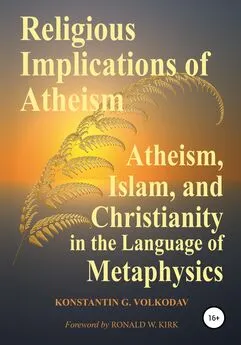Konstantin Volkodav - Religious Implications of Atheism
- Название:Religious Implications of Atheism
- Автор:
- Жанр:
- Издательство:неизвестно
- Год:2021
- ISBN:978-5-532-95383-3
- Рейтинг:
- Избранное:Добавить в избранное
-
Отзывы:
-
Ваша оценка:
Konstantin Volkodav - Religious Implications of Atheism краткое содержание
Religious Implications of Atheism - читать онлайн бесплатно ознакомительный отрывок
Интервал:
Закладка:
Let us explain the above with examples. Spontaneous electromagnetic radiation by atoms or spontaneous fission of heavy atomic nuclei occurs due to the instability of their energy (or other) state. The time of this event cannot be precisely determined, but is described probabilistically, according to the corresponding distribution function.
However, can we talk about the spontaneous emergence of the laws of physics (as Krauss says)? Of course not. For spontaneous occurrence of a photon, at least a hydrogen atom is needed. If the atoms (matter) themselves do not exist, then there will be no phenomenon of spontaneity, no wave functions of electrons, etc. The same can be said about the vacuum, which has energy and is capable of producing particles. Krauss wrote in his book A Universe from Nothing :
“The existence of energy in empty space-the discovery that rocked our cosmological universe and the idea that forms the bedrock of inflation-only reinforces something about the quantum world that was already well established in the context of the kinds of laboratory experiments I have already described. Empty space is complicated. It is a boiling brew of virtual particles that pop in and out of existence in a time so short we cannot see them directly.” [20] . Krauss, A Universe from Nothing . Ch. 10: Nothing is Unstable, 154.
But this means that the “empty space” that cosmologists study is not “nothing” at all, but a physical (material) object under the conditions of space-time and the existing laws of physics.
Cosmologists talk about quantum fluctuations of the physical vacuum, about the spontaneous emergence of particle-antiparticle pairs in very strong electric fields from “nothing”, about fluctuations of the scalar field (which allegedly gave rise to the universe). However, all these examples are taken from the material world with already existing physical laws. Thus, by “nothing” cosmologists mean, as it were, a special “pra-matter” that existed outside space and time. All theories that talk about the possibility of the emergence of the universe from “nothing” require the preliminary existence of the laws of physics and a special “nothing” that has the potential to give birth to quantum particles.
However, it begs the question: how did the laws of physics themselves emerge if there was nothing material yet, and why the original “nothing” could have any potential. Krauss quotes Richard Feynman in Preface of A Universe from Nothing : “The laws of physics could be like an infinitely layered onion, with new laws becoming operational as we probe new scales.” In addition, a little earlier, he recalled about the famous “story of an expert giving a lecture on the origins of the universe (sometimes identified as Bertrand Russell and sometimes William James), who is challenged by a woman who believes that the world is held up by a gigantic turtle, who is then held up by another turtle, and then another . . . with further turtles ‘all the way down!’” [21] . Krauss, A Universe from Nothing . Preface, 18.
In fact, there are not only turtles, but a whole zoo: an elephant, a boa constrictor, a tiger, wild boars and a whale that swims in a bottomless and endless ocean. Krauss and those to whom he refers are arguing with representatives of the Abrahamic religions, in whose cosmogony there is nothing of the kind. But for the sake of argument, wanting to ridicule religion, Krauss mentions this “zoo” of Hinduism. However, he does not realize that he is ridicule of himself.
Only someone who is very stupid will take the ancient metaphor literally. The opposition of ancient myths and scientific cosmogony is already a myth in itself, a method of demagoguery.
People in ancient times were not stupid. For example, Thales of Miletus predicted a solar eclipse in 585 BC, having learned the necessary knowledge in the field of mathematics and astronomy from the ancient Egyptians. Aristarchus of Samos in the third century BC argued that the Earth and other planets revolve around the Sun. He also calculated that the Sun is about eighteen times farther from the Earth than the Moon. Copernicus created a heliocentric system based on ancient heritage (and referred to ancient authors).
Therefore, the ancient myth of the Earth on turtles was never considered as a scientific theory, but served as a metaphor that illustrates the state of mind of a rationally thinking man in the street. If the Earth were floating directly in the ocean, a natural question would immediately follow: is there anything further, at the bottom of the ocean and below it? But when there is a long chain of mysterious creatures between the Earth and the ocean, human curiosity is largely satisfied, and the person is no longer interested in whether there is anything at the bottom of the ocean.
Using this metaphor, the ancient authors wanted to show that no matter how deeply scientists advance in the knowledge of nature and space, they would discover more and more “animals” (essences, laws of matter) and further advance along the chain of knowledge. However, no matter how far they go, there will always be an unknowable ocean ahead. This is what the ancient people understood and what modern atheist scientist does not understand.
Physicists are constantly finding more and more “turtles”—more and more new laws, effects, and essences. Of course, the reliability of physical facts is beyond doubt, but the endless sequence of correct explanations itself now plays the role of a zoo from ancient myth. Physicists have learned to split protons, but how long can subatomic particles be split? Is there anything smaller than the Higgs boson? Physicists are constantly discovering new elementary particles, but how elementary are they? Atheists stubbornly refuse to notice the obvious fact that no matter how far science has advanced, there will always be an ocean of the unknown in the distance.
About the same thing was said by one of the giants of science, Sir Isaac Newton. His quote is widely known, in which he uses a metaphor that is close in meaning:
“I do not know what I may appear to the world; but to myself I seem to have been only like a boy playing on the sea-shore, and diverting myself in now and then finding a smoother pebble or a prettier shell than ordinary, whilst the great ocean of truth lay all undiscovered before me.” [22] . Isaac Newton (1642–1727). In Brewster, Memoirs of Newton (1855), vol II, Ch. 27. https://www.brainyquote.com/quotes/isaac_newton_387031
Since the time of Isaac Newton, our knowledge of the Universe has expanded significantly, but we also stand only on the shores of the “great ocean of truth”. Physicists have always been and will be doing the same thing as Newton: looking for “a smoother pebble or a prettier shell”, while before them there will always be an unexplored great ocean of truth.
The situation in atheistic cosmology resembles not only a metaphor with turtles, but also a trick with getting rabbits out of an “empty” hat. The only difference is that quantum cosmologists imperceptibly take out of their pocket or from under the table not rabbits, but the formulas of quantum mechanics, wave function, scalar field, etc. and put all this into the original “nothing”.
For example, in the theory of the quantum creation of the universe, it is postulated (i. e., it is proposed to believe!) That the universe arose from an unreal quantum field that did not exist in the physical sense, that is, it is a purely mathematical abstraction, called by A. Vilenkin “literal nothing”. [23] . Vilenkin, “Creation of Universes from Nothing”, 25–28.
Then watch his hands! This mathematical “literal nothing” due to spontaneous fluctuations was able to give rise to a pseudo-real particle, representing the embryo of the future universe. Moreover, it, in turn, with the help of quantum tunneling overcame the barrier separating the abstract mathematical world from physical reality!
Good trick! However, physics cannot arise from mathematics just because some physicists want it, and they skillfully juggle formulas. Materialists go beyond the applicability of scientific theories that describe our world when they try to talk about something “before” the world came into being. The trick does not cease to be a trick from the fact that “serious people” with high ranks and regalia and with an intelligent look perform it. “A smart face is not yet a sign of intelligence, all stupidity on Earth is done with just such an expression.” [24] . “That same Munchausen” is a Soviet artistic two-part television movie in 1979. The play “The Most Truthful” by Grigory Izrailevich Gorin served as the literary material for the script. It was written in the play, “A serious face is not yet a sign of intelligence, all stupidity on Earth is done with just such an expression.” However, when dubbing the movie, Yankovsky made a reservation, saying, “A smart face is not yet a sign of intelligence.” In this form, the phrase, despite G. Gorin’s protests, remained in the movie.
In any case, all this rhetoric does not remove the main question: how did the laws of physics arise and why are they exactly like that?
Maybe there will be a boy who will say, “But the king is naked!” It is only in fairy tales that you can lift yourself into the air by your hair or by your laces. Ontologically, physics (that is, the totality of the laws of matter) cannot create itself. Albert Einstein once remarked that it is impossible to solve a problem by thinking the same way as those who formulated it. To solve the problem of the emergence of the material universe, it is necessary to go beyond the “level of physics”; after all, not without reason, the outstanding thinkers of humankind spoke about metaphysics and philosophy.
Could physics give the initial impulse for the emergence of the universe, if it did not exist at first? The question is rhetorical. What comes first, physics or metaphysics, matter or spirit? There must be a final limit, beyond which there is no longer physics. This limit is non-being (Lat. nihilo, Gr. οὐκ ὄν). This is absolute non-being (non-existence, nothingness), a denial of any existence (any of its forms), and a denial of any being. It lacks any essence, potency, inner laws and anything else. In non-being, there are not only the laws of physics, but also even the laws of abstract mathematics.
A great many scientific books and articles on the emergence of the universe from “nothing” have been written. Although the approaches and methods in these scientific works may differ, they are all based on one glaring logical error and can only fascinate science fanatics. The error lies in the fact that the authors speak the language of physics and mathematics about the moment of the origin of the universe, about the initial singularity, ie in the language of the material world, which did not yet exist at that moment. The universe arose not from a physical or mathematical vacuum, but from non-being (nothingness), in which there was no physics, no mathematics. Obviously, when there was no “physics” (ie the material world), there were no laws of physics either. Therefore, no scientific formulas and equations make sense in the original singularity.
It remains to recognize that the act of creating out of nothing requires a person, a creator, who is transcendental in relation to his creation. Moreover, this is not just a philosophical conclusion, but also a fundamental ontological Law, similar to the First and Second Laws of thermodynamics. Just like the Laws of thermodynamics, this Law is not proved, but enunciated inductively.
Читать дальшеИнтервал:
Закладка:

![Константин Бальмонт - Константин Бальмонт и поэзия французского языка/Konstantin Balmont et la poésie de langue française [билингва ru-fr]](/books/613502/konstantin-balmont-konstantin-balmont-i-poeziya-frantsuzskogo-yazyka-konstantin-balmont-et-la-po-sie-de-langue-fran-aise-bilingva-ru-fr.webp)






